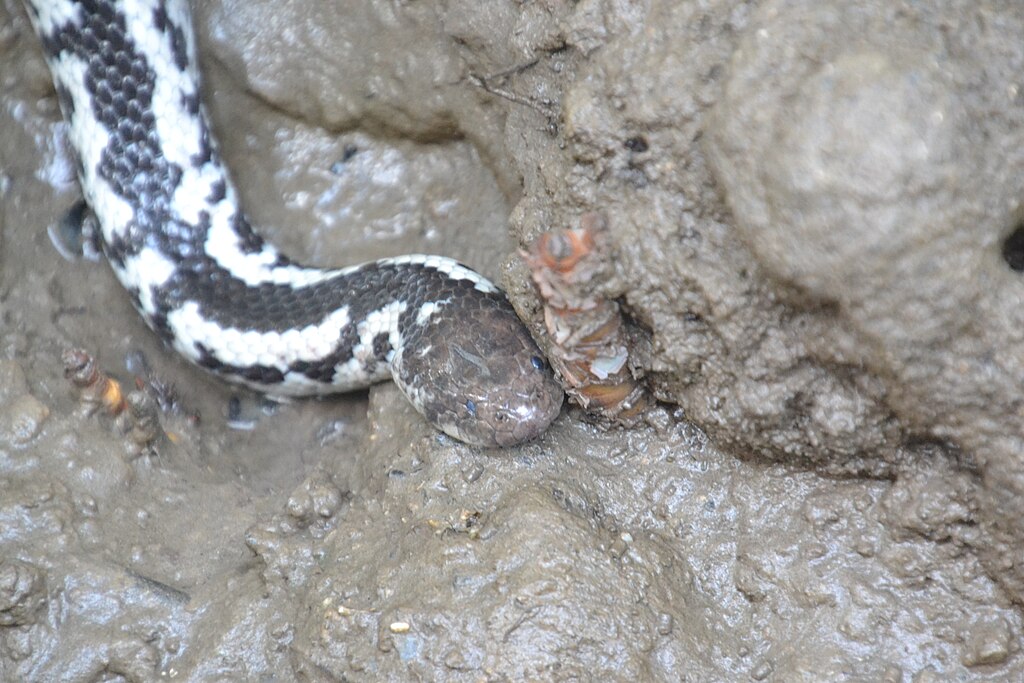Deep within the dense tropical rainforests of Southeast Asia lives a remarkable reptile with an extraordinary lifestyle – a snake that spends its entire life in trees, never voluntarily descending to the ground. The Boiga dendrophila, commonly known as the Mangrove Snake or Gold-ringed Cat Snake, represents one of nature’s most specialized arboreal adaptations. These serpents have evolved unique physical characteristics and behaviors that allow them to thrive in their elevated habitats, creating a fascinating study in evolutionary specialization. Their tree-dwelling existence has shaped everything from their hunting strategies to their reproductive behaviors, making them one of the most interesting yet lesser-known snake species in the world.
The Ultimate Arboreal Specialist
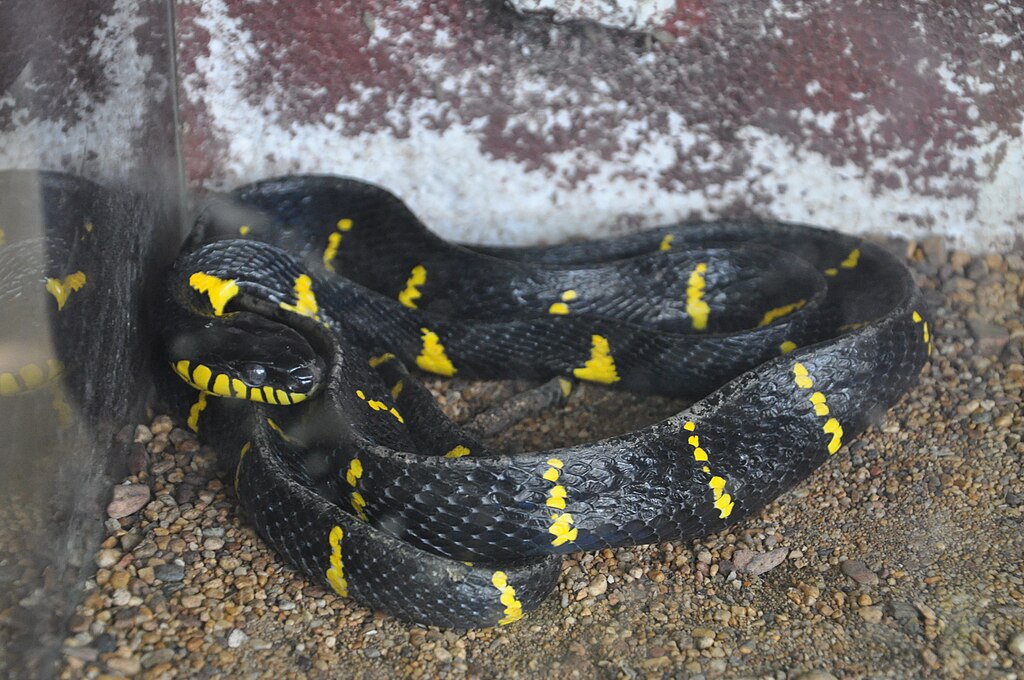
The Mangrove Snake stands out as one of the most committed arboreal specialists in the snake world, having developed a lifestyle completely adapted to life among the branches. Unlike many snake species that climb trees occasionally for hunting or thermoregulation, these remarkable reptiles live their entire lives above ground, from hatching to death. Their bodies have evolved specifically for navigating the complex three-dimensional environment of the forest canopy, with specialized muscles and skeletal structures that support their weight across gaps between branches. This extreme specialization demonstrates how evolution can produce creatures perfectly matched to ecological niches, even when that niche is as challenging as permanent life suspended above the forest floor.
Physical Adaptations for Tree Life

Everything about the Mangrove Snake’s physiology speaks to its tree-dwelling existence, starting with its slender, lightweight body that allows for agile movement through branches. The snake possesses a laterally compressed form that helps it balance along narrow branches, while its exceptionally long tail provides crucial support when stretching between limbs. Most striking are its large, forward-facing eyes with vertical pupils that provide excellent depth perception and night vision – essential for a predator that hunts in the complex, shadowy environment of the forest canopy. The snake’s skin features a striking pattern of black with bright yellow bands, which breaks up its outline when resting among dappled light and shadow of leaves, offering perfect camouflage from both predators and prey.
The Perfect Grip: Specialized Scales
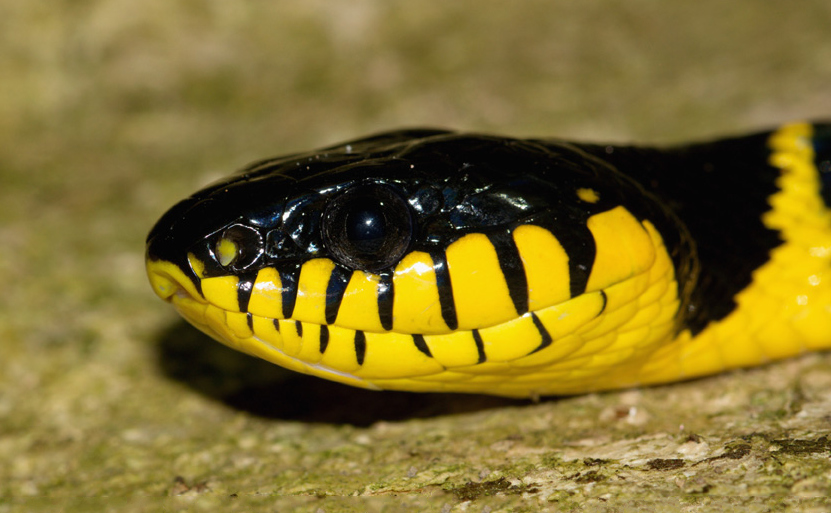
The Mangrove Snake’s ability to move through trees without falling is largely due to its specialized ventral scales that have evolved specifically for arboreal locomotion. These belly scales have microscopic ridges and slightly upturned edges that create tremendous friction against bark and branches, allowing the snake to grip even smooth surfaces at seemingly impossible angles. When examined under magnification, these scales reveal complex structures that maximize surface contact with tree bark, giving the snake unprecedented control during movement. The scales are also slightly concave, creating a partial vacuum effect when pressed against flat surfaces, further enhancing the snake’s grip during challenging maneuvers. This remarkable adaptation allows the snake to climb vertical trunks, hang upside down, and navigate the thinnest branches with confidence.
Hunting Strategies Above Ground
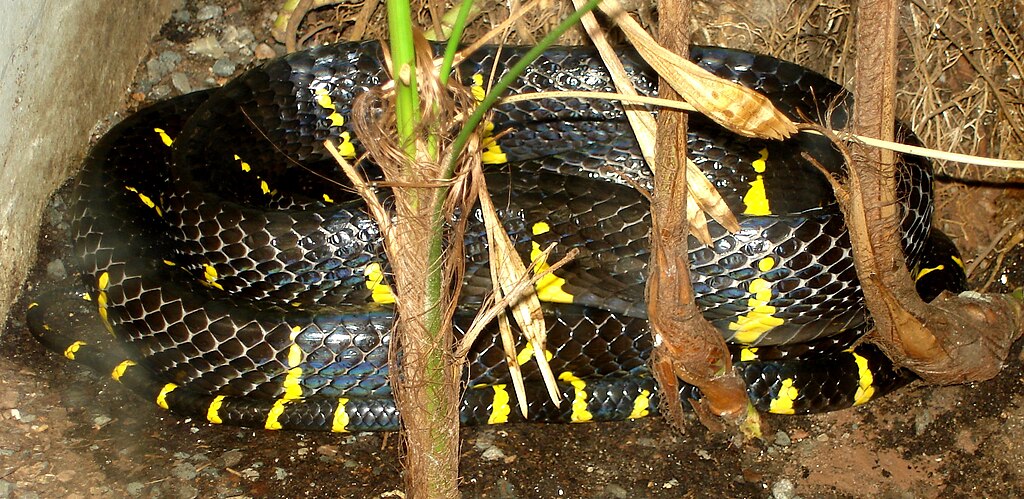
The Mangrove Snake has developed hunting techniques perfectly suited to its arboreal lifestyle, employing both ambush and active hunting strategies depending on circumstances. These nocturnal predators typically remain motionless for hours, draped over branches where birds and small mammals are likely to pass, striking with remarkable speed and precision when prey comes within range. Their slightly venomous bite, delivered through rear fangs, immobilizes prey quickly, preventing escape through the complex branching structure of the trees. Perhaps most impressive is the snake’s ability to track prey through the three-dimensional environment of the canopy, following scent trails that wind through multiple levels of vegetation. This combination of patience, speed, and sensory acuity makes them formidable predators despite never touching the ground.
A Diet of Canopy Dwellers

Living permanently in trees has forced the Mangrove Snake to specialize in hunting prey that shares its elevated habitat, creating a diet distinct from ground-dwelling serpents. Their primary food sources include arboreal lizards, small birds, bats, and tree-dwelling rodents – essentially any small vertebrate that can be overpowered and consumed while navigating branches. The snake has developed specialized digestive adaptations to process these meals efficiently, as hunting opportunities can be unpredictable in the canopy environment. Their jaws can dislocate to consume prey larger than their own head diameter, while their digestive systems extract maximum nutrition from each meal, allowing them to go weeks between successful hunts if necessary. This dietary flexibility is crucial for survival in an environment where prey encounters may be less frequent than on the forest floor.
Reproduction Without Descending

Even the reproductive cycle of the Mangrove Snake takes place entirely within the trees, representing a complete adaptation to arboreal living. Mating occurs on sturdy branches where males compete for females through complex courtship displays that involve gentle biting and body undulations that demonstrate strength without risking falls. Female snakes are oviparous, laying clutches of 4-15 eggs in hollow tree trunks, abandoned bird nests, or accumulated plant debris caught in branch forks. The selection of egg-laying sites shows remarkable discernment, as the female must find locations that provide stable temperature and humidity conditions throughout the incubation period of approximately 90 days. This reproductive strategy ensures that even the youngest generation begins life exclusively in the trees, never experiencing ground contact.
Defense Mechanisms in the Canopy
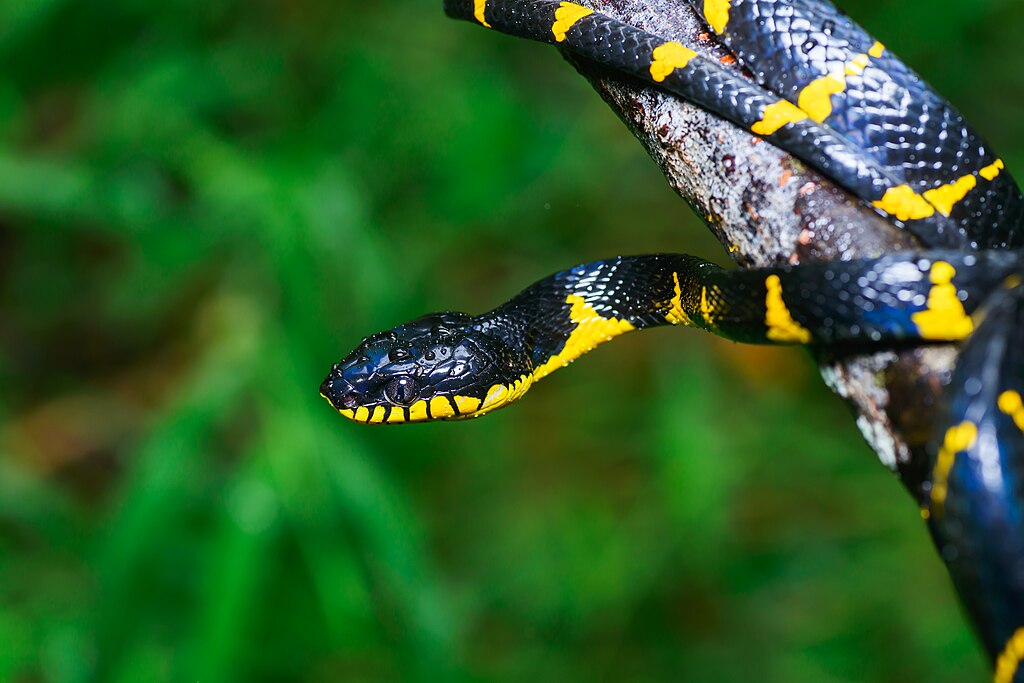
Without the option to flee underground when threatened, the Mangrove Snake has developed innovative defense strategies that protect it while remaining in its arboreal domain. When confronted by potential predators like larger birds or primates, the snake will often flatten its neck vertebrae to appear larger while displaying its vibrant yellow bands more prominently – a form of aposematic coloration that warns of its mild venom. If physical confrontation becomes unavoidable, the snake can execute lightning-fast strikes while maintaining secure anchoring with its posterior body, preventing falls during defensive actions. Perhaps most impressive is its ability to vanish by sliding around to the opposite side of a branch or trunk with extraordinary speed, seemingly disappearing from a predator’s view in an instant.
Social Behavior Among the Branches

Despite the solitary reputation of most snake species, the Mangrove Snake displays subtle social behaviors that suggest a more complex social structure than previously recognized in arboreal serpents. Researchers have documented multiple individuals sharing preferred hunting perches during different time periods, indicating a possible time-sharing arrangement of prime territories. During breeding season, complex interactions beyond simple mating have been observed, with males engaging in ritualized displays that establish dominance without physical combat that might risk falls. Most intriguing are observations of communal basking sites where multiple individuals may gather on sun-exposed branches during cooler mornings, suggesting some level of social tolerance unusual among solitary predators.
Navigational Abilities in Three Dimensions
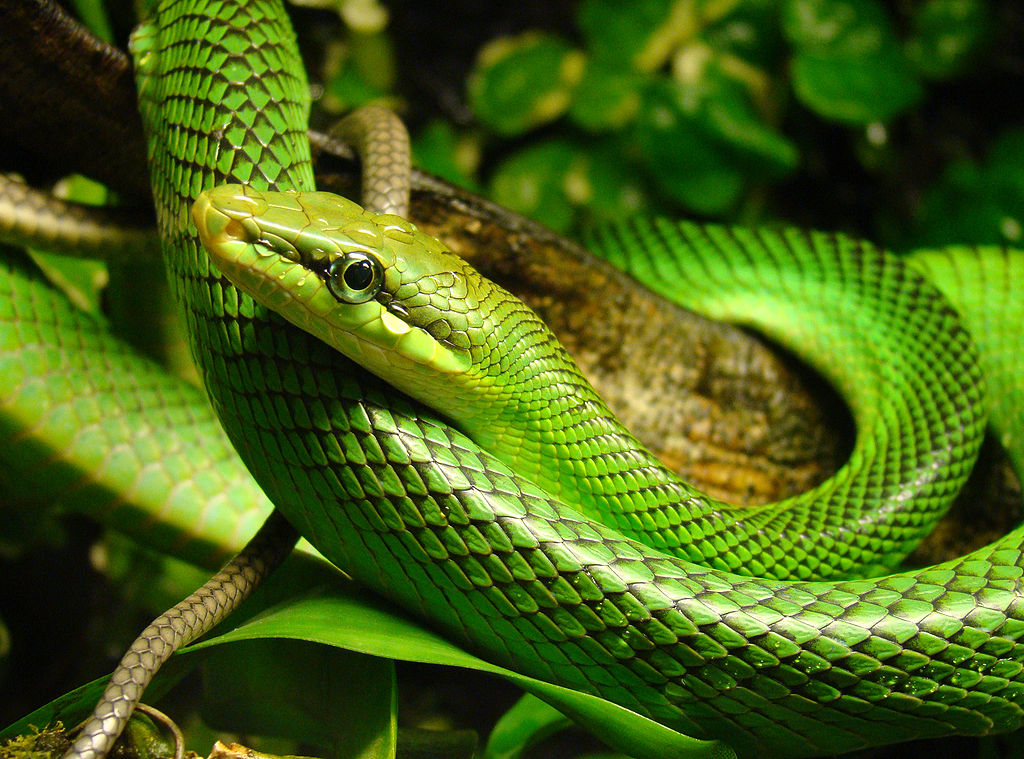
The cognitive mapping abilities of the Mangrove Snake represent some of the most sophisticated spatial awareness documented in reptiles, allowing them to navigate the complex three-dimensional environment of the forest canopy. These snakes develop mental maps of their territory that include not just horizontal pathways but vertical connections between different canopy levels. Studies have shown they can remember reliable routes between hunting grounds, basking spots, and shelter locations across areas spanning hundreds of meters of forest. Their ability to calculate complex movements that require multiple direction changes while maintaining balance has led researchers to reconsider reptilian cognitive abilities. This navigational prowess allows them to move efficiently through their habitat while conserving the energy that would be wasted through random exploration.
Relationships with Other Canopy Species
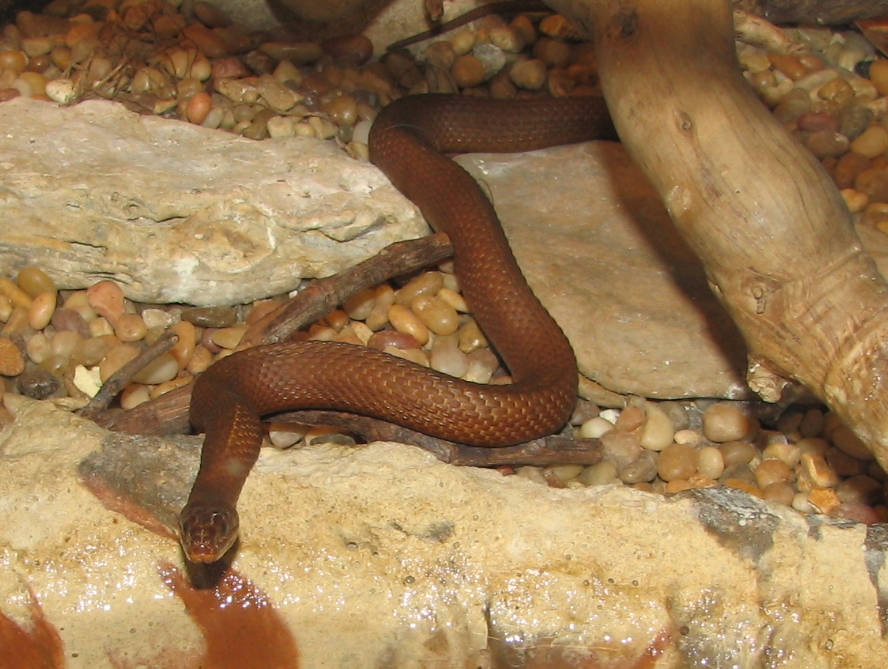
The permanent presence of Mangrove Snakes in the canopy has led to intricate ecological relationships with other tree-dwelling species beyond simple predator-prey dynamics. Bird species in their habitat have evolved to recognize and respond to these snakes with specific alarm calls that differ from those used for ground-based predators. Interestingly, certain primate species will tolerate the snake’s presence near their social groups, as the snake preys on rodents that might otherwise raid the primates’ food sources. Perhaps most fascinating is the relationship between these snakes and certain epiphytic plants that grow in the canopy – the snake’s feces provide concentrated nutrients that benefit these plants, while the dense vegetation offers ideal hiding spots for the serpent. This creates a subtle mutualism where both species benefit from the other’s presence in the shared arboreal environment.
Conservation Challenges
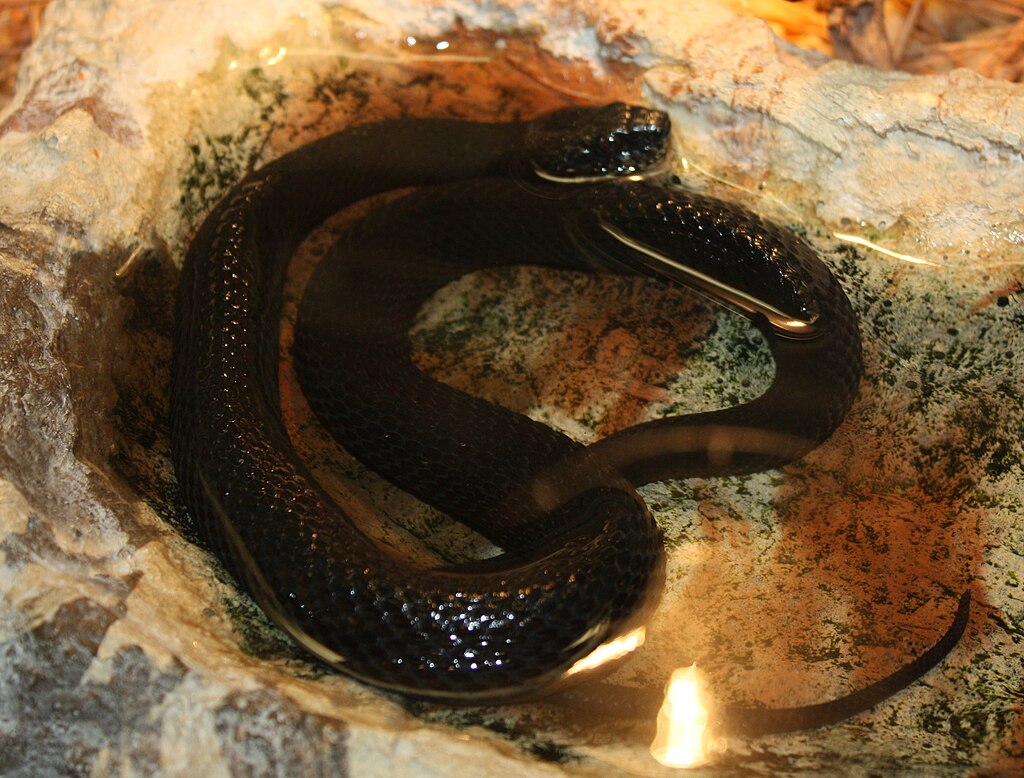
The specialist lifestyle of the Mangrove Snake makes it particularly vulnerable to habitat disruption, creating unique conservation challenges for this arboreal species. Deforestation presents the most immediate threat, as these snakes cannot simply relocate to ground habitats when trees are removed, leading to direct population collapse in logged areas. Climate change poses additional risks by altering the temperature and humidity conditions in the canopy microclimate that the snakes depend on for successful reproduction and prey availability. Conservation efforts are complicated by the difficulty of studying these elusive canopy dwellers, as traditional ground-based survey methods fail to accurately assess population dynamics. Successful protection requires preserving intact forest canopy structures rather than just forest area, necessitating specialized conservation approaches that maintain the three-dimensional integrity of tropical forest ecosystems.
Myths and Cultural Significance
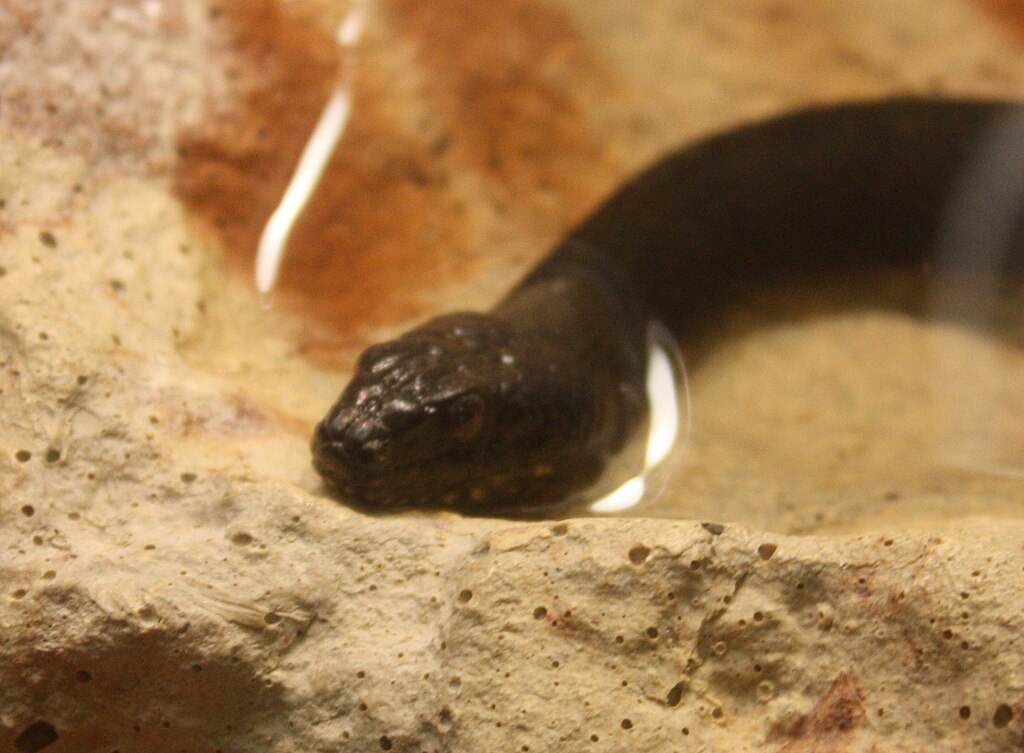
The mysterious nature of this permanently arboreal serpent has generated rich mythology among indigenous cultures of Southeast Asia, where it features prominently in folklore and traditional beliefs. Many tribal groups consider the snake a protective spirit of the forest canopy, believing its presence ensures the health of the trees and the continuation of seasonal rains. In parts of Borneo, traditional beliefs hold that dreams of the gold-ringed snake bring messages from ancestors who reside in the upper world represented by the forest canopy. Some traditional healing practices incorporate symbolic representations of the snake in treatments for balance disorders and fear of heights, reflecting the creature’s mastery of life in the precarious upper reaches of the forest. These cultural associations have sometimes aided conservation efforts by embedding protection of the species within local value systems and traditional forest management practices.
The Mangrove Snake exemplifies nature’s capacity for extreme specialization, having evolved to occupy an ecological niche that few other reptiles could survive in. By committing entirely to an arboreal existence, these remarkable serpents have developed physical adaptations, behaviors, and life strategies that allow them to thrive without ever touching the ground. Their story reminds us that evolution often produces specialists whose entire biology becomes intricately adapted to specific environmental conditions. As we continue to learn more about these canopy dwellers, they offer valuable insights into the complexity of forest ecosystems and the remarkable adaptability of reptilian life. In a world of increasingly threatened forest habitats, the snake that never leaves its tree stands as a powerful symbol of the specialized life forms we risk losing without comprehensive conservation efforts.

